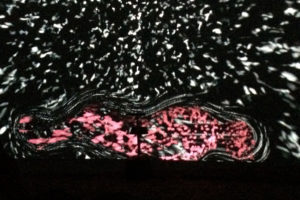10^ -22 sec
choreographic installation for 1 dancer,
visuals, movement sensors and instant music composition
CHOREOGRAPHER’S NOTE
In my work 10^ -22 sec, the theoretical research focus on the Higgs particle and the spontaneous symmetry breaking in physics. The symmetry breaking in physics describes a phenomenon where little variations which act on a system that passes a critical point, decide the fate of the system by determining the way out, of many possible directions, this will take. I defined my body as a core and my parts of the body as particles which, as they move and come out of the core, break the symmetry. The rupture of symmetry happens both with the moving of the body in space, and the moving of its parts, which they mentally break the symmetrical axis of the human body moving in different directions. In my performance, the quiet linearity and elliptical circularity coexist in their choreographic perception touching and maintaining an interactive approach. They “talk”, “meet” and “collated” with each other. In the beginning, the vertical line of the body is energetic, dynamic and rigorous. The vertically placed body as a point in the center of the space, I could say, is like a first painted image in a silent empty space that produces the first “sound”, giving us at the same time a sense of immobility and stasis. In the first part of the performance, the kinetic approach is symmetrical with horizontal and diagonal lines signifying stability, harmony and tranquility. The composition of movements is based on repetition, which gives to the choreography unity and cohesion. The repeated movements are organized in rows and appear in intervals, producing rhythm and a sense of continuous movement flow. In the second part, permutations and variations of the repeated body lines convey a sense of dynamics and collisions while the choreography starts to interact with the audiovisual installation and takes gradually an asymmetrical form. Free lines, zigzags and intersecting lines produce acidity while curves express fluidity and flexibility. Thus, the performance, as it evolves, acquires a character of instability in a thin, high precision, asymmetrical balance. The video projection, as a stellar sea wrapping the dancer, works like a veil of body protection. The movements with its axes are the visible or imaginary lines that function as paths, followed by the eye of the audience, allowing it to “read” the choreography.
ABSTRACT
In 2012, a few months after the discovery of the Higgs boson, the Italian National Institute for Nuclear Physics (INFN) created the audiovisual installation, entitled The Gift of the Mass. In February 2016, the art@CMS, programme of the CMS Experiment at CERN, assigned to the dancer and choreographer Spyros Kouvaras to create a choreographic, interactive performance between a body and the audiovisual installation inspired by the Higgs field, the physical phenomenon whereby the elementary particles acquired their mass in primordial Universe. So, the choreographer created, 10^ -22 sec, in which body and audiovisual installation create an interactive approach between them. With the use of projectors and movement sensors, the dancer through his movement seems to lose and acquires virtually his mass. Both the performance and the installation do not try to explain what really the Higgs field is. But they rather create a kinetic environment where the audience can also create their own presence, thereby leaving room for reflection and interpretation.
CREDITS
Production: Athens Science Festival Support: art@CMS – programme of the CMS Experiment at CERN, Science View Choreography, Performance: Spyros Kouvaras Audiovisual Installation: INFN / Embrio.net – Paolo Scoppola Instant Music Composition: Konstantinos Vasilakos









